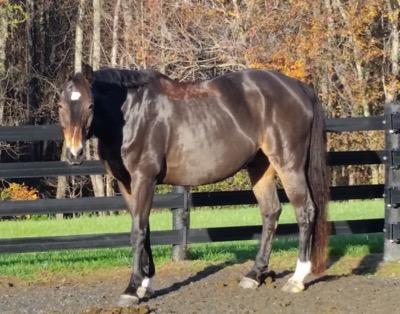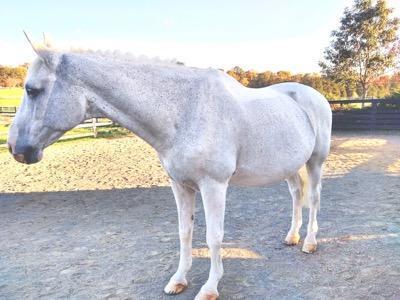Tips on When to Clip Your Horse in the Fall
Deciding when to clip your horse during the fall is pivotal to ensuring their comfort and well-being. But how do you determine the ideal timing for this procedure? Is there a “Best Day?” No – Every scenario has nuances, and several factors come into play. Ultimately, when to clip your horse in the fall depends on your horse’s health and comfort, their hair growth timeline, and how their regular work and exercise affect sweating and cooling.
Table of Contents

Many fall days are warm enough to be “naked” after a clip.
How to Pick the Best Clipping Time
- You should clip your horse in the fall so they remain comfortable, not too sweaty, can cool out well, and their skin remains healthy. Most of this is a giant experiment in preparation for the coming colder months, and as horse owners, the time of year shouldn’t matter if we notice that a clip could benefit our horse.
Clip around your horse’s natural shedding and growth
- A gradual shift begins as the summer solstice approaches in late June, ushering in the longest day with ample sunlight. Following this solstice, daylight hours gradually decrease, especially in northern regions, where seasonal variation is more pronounced than in the warmer months of the south.
- Horses notice these daylight fluctuations via photoreceptors in their eyes. That information is relayed to their brain, thus starting to shed their summer coat and replacing it with a thicker winter coat, ready for the cold climate.
- Typically, this shedding and growth phase begins around six weeks after the solstice, although variations may occur due to genetic and geographical factors.
- The progression of shedding spans several weeks, as does the growth of new, longer hair. During this period, your responsibility is to ensure your horse remains comfortable in their surroundings and your horse’s skin remains healthy.
Metabolic disorders and winter coats
- In some instances, the horse that typically grows three extra eyelashes for a winter coat develops a metabolic disorder, resulting in excessive hair growth.
- Pituitary pars intermedia dysfunction (PPID, formerly known as Cushing’s disease in horses) triggers a hormonal cascade that increases cortisol levels. Cortisol is responsible for many things, one of which is signaling the horse’s skin to grow hair.
- The result is muscle loss, insulin resistance, an increased risk of laminitis, and an unruly winter coat. Body clipping and trace clipping can help. This might become a year-round thing for PPID horses.
Match your horse’s coat to the weather
- Contrary to popular belief, the temperature isn’t the sole factor governing your horse’s coat growth. Genetic predisposition and daylight hours dictate when your horse sheds and grows a new coat.
- Genetics rule how much hair grows, and how long hair becomes in the new, thick winter coat.
- Let’s not forget that even in warmer climates, winter coats can develop as a reaction to the changing hours of sunlight.
- Your horse might have excess hair for your climate. Many types of clips can help with this!
Wet weather hazards for legs
- A common skin infection, mud fever, is more likely to occur in colder weather and wet conditions. Extra moisture from snow and rain, coupled with thicker feathers, can trap bacteria on the fetlock region and become a science experiment.
- Trimming or clipping the feathers is one way to keep the lower leg skin in good condition and reduce the likelihood of the leg hair collecting mud and gunk.

Long fuzzy coats are great for horses that don’t sweat much in cold weather. Add a clip to your grooming routine for lots of training and sweating.
Line up your horse’s activity level and their coat for sweat management
- Horses in training or showing through the winter gain considerable benefits from clipping, as it alleviates excessive sweating.
- Clipping thick coats minimizes sweating, reduces the risk of overheating, makes cooling out more efficient, and curbs potential skin issues like rain rot that result from sweat, dirt, and bacteria trapped on the skin.
- A sweaty horse in cold weather, doing heavy work, can face fitness challenges as their body heats up. Naturally, sweat aims to negate this, but a natural coat that is soggy with sweat takes extra time to dry and must be handled carefully to help regulate your horse’s body temperature. No chills needed!
- When considering what type of horse clipping would work best, let the sweat be your guide and clip or trim the particularly sweaty areas.
Strategic Timing: September and October Clipping
- The optimal period for most horses to undergo clipping typically falls between September and October. By opting for an early clip in September, you facilitate the growth of a sufficient winter coat post-clipping. Your horse may need to be touched up later in the season.
- Alternatively, a clip towards late October or beyond results in the removal of longer hair. Perhaps this is the only time you need to clip your horse.
- Because the coat continues to shed and regrow throughout the year, you will notice that a clip smooths out as the hair grows. As winter crawls along, the weather and your horse will tell you if a touch-up is needed.
A hybrid method of clipping your horse in the fall
- If you body clip your horse early in the shedding and growing cycle, say early September, there will be a lot of growth that follows.
- You can touch up with a trace clip, like a hunter clip, bib clip, or Irish clip, later in the season. This selective clipping allows the sweaty parts to get relief, while your horse’s legs, belly, and face stay warm in the colder weather.
- You may only need to touch up a few sparse areas, like the underside of the neck or around the flank. Your horse’s clip should always reflect their sweat patterns.
When to Clip Your Horse in the Fall – More Factors to Consider
- Consider your horse’s barn routines and training plans when determining the best times to clip.
When can you bathe your horse in the fall?
- A successful clipping operation begins with a clean canvas. Thorough grooming and bathing lay the groundwork for effective clipping. Coupled with sharp, sanitized blades, the clipping process becomes significantly smoother. While hot toweling with a damp sponge and grooming can substitute for bathing, a full shampoo bath is recommended whenever possible.
Look ahead to January and February
- Unseasonably mild falls don’t necessarily guarantee gentle winters. A September or October clip is an excellent idea if autumn temperatures are too high for your horse’s developing winter coat.
- As temperatures drop, your horse’s coat will continue to grow out if January and February are wicked cold. Clip earlier and skip any touch-up clips.
- If January and February are traditionally mild, it’s a good idea to touch up as needed.

This very fresh body clip has a half face and fuzzy saddle pad.
Mix and match trace clipping patterns
- There is no rule about choosing a full body clip or any one of the common types of clips. You can do both! Use the calendar and the weather to guide you.
- You can also turn your horse into a work of art with their clip, designed for their sweat.
- You may find that your horse’s workload changes from heavy or medium work to light work in the winter months, in which case you can adjust their clipping needs.
Change the clipper blades
- The beauty of the many types of horse clippers is that they all have many kinds of blades.
- You may find you want to use the traditional #10 blade for body and trace clipping, or switch to a #7F that leaves more hair.
Plan for blankets
- Clipped horses generally require winter blankets in cold weather. With a range of blanket options available, your choice depends on your horse’s coat length and weather conditions. Prioritize waterproof blankets to streamline the blanketing process, provide extra warmth, and guard against sudden wet weather.
- Your barn’s blanketing services may influence when to clip your horse in the fall.
Ultimately, your horse’s unique needs should guide your decision regarding the clipping timeline, preferred style, and potential for follow-up clips.
Video

FAQ’s
How late is too late to clip a horse?
It’s never too late to clip, but make sure your horse can handle the cold. In freezing temps, a fresh body clip exposes them to extreme cold. Instead, choose a trace clip that keeps the face, belly, and legs furry. The clipped areas will be fine under a blanket.
Is it too early to clip my horse?
No! It’s only too early to clip if you can’t keep your horse protected after clipping. In the spring, you may still need sheets to account for chilly nights. In the fall, you may clip too early and need to clip again as the winter coat grows.
What if it’s too cold to bathe in the fall?
Hot toweling your horse with cloths, no-rinse shampoo, and hot water recreates a deep cleaning to help prepare your horse for clipping. Groom your horse thoroughly and use a horse vacuum if you have one before hot toweling for best results.
Are there specific clip patterns recommended for horses in the fall?
If your horse doesn't need a full body clip, opt for any trace clip that trims the sweaty areas of your horse. This could be a simple bib clip, or a more dramatic trace clip. You don't have to follow a pattern. Instead, remove the hair where it's most likely to interfere.
Go Shopping
Stock up here for your horse supplies! As an Amazon Associate, I earn from qualifying purchases, but it’s ZERO extra cents to you. As a Walmart Associate, I earn from qualifying purchases as part of their affiliate plan. I appreciate your support! You can also visit my Amazon storefront here: PEG storefront.
This is my favorite clipper - It's great for body clipping, trace clipping, and trimming. Cordless for the win!
This new KM cordless clipper has constant power, no matter the haircoat, and rechargeable batteries that last 3 hours. It's quiet, and the wide blade makes clipping faster.
These powerful trimmers have a 90 minute run time, and you can use them as you charge if needed!
This fantastic clipper blade leave a whopping 4 mm of hair!
These wildly powerful shears are great for thick coats, and when I say thick, I mean it.










